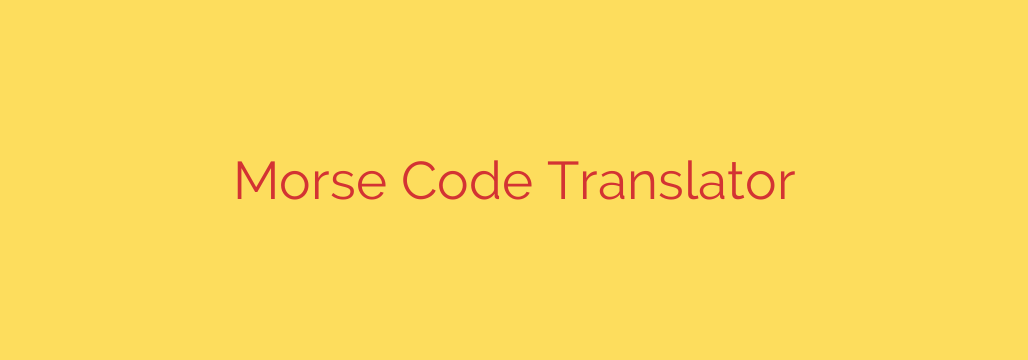
Unlock the Secrets of Morse Code: A Complete Guide
Long before smartphones and instant messaging, a revolutionary communication system connected the world using simple pulses of sound and light. This system, Morse code, remains a fascinating and surprisingly relevant part of our technological history. Whether you’re a history buff, a radio enthusiast, or simply curious, this guide will demystify the language of dots and dashes.
What Exactly is Morse Code?
Morse code is a character encoding system that allows operators to send text messages using a series of short and long signals. These signals, commonly known as dots and dashes, can be transmitted through sound, light flashes, or electrical pulses.
Invented in the 1830s by Samuel Morse and Alfred Vail, it was the primary method for long-distance communication for over a century. Each letter of the alphabet, every number, and some punctuation marks are assigned a unique sequence of dots and dashes. A short signal is called a “dit” (dot), and a long signal, which is three times longer than a dit, is called a “dah” (dash).
The International Morse Code Alphabet
To translate or learn Morse code, you must first understand its alphabet. The International Morse Code standard is the most widely used version today. Below is the complete alphabet and numbers for your reference.
Letters:
- A: .-
- B: -…
- C: -.-.
- D: -..
- E: .
- F: ..-.
- G: –.
- H: ….
- I: ..
- J: .—
- K: -.-
- L: .-..
- M: —
- N: -.
- O: —
- P: .–.
- Q: –.-
- R: .-.
- S: …
- T: –
- U: ..-
- V: …-
- W: .–
- X: -..-
- Y: -.–
- Z: –..
Numbers:
- 1: .—-
- 2: ..—
- 3: …–
- 4: ….-
- 5: …..
- 6: -….
- 7: –…
- 8: —..
- 9: —-.
- 0: —–
Practical Tips for Learning Morse Code
Learning Morse code is like learning any new language—it requires patience and practice. However, its simple structure makes it accessible to anyone.
Listen, Don’t Just Memorize: The most effective way to learn is by associating each character with its sound, not by counting dots and dashes. Listen to recordings and focus on the rhythm of each letter. The sound for “R” (.-.) should become a single auditory chunk, “di-dah-dit.”
Use Word Association: Mnemonic devices can be incredibly helpful. For example, the letter “C” is -.-., which has a rhythm similar to the phrase “Coke-a-Co-la.” Find or create associations that work for you.
Practice Consistently: Start by learning the most common letters first (like E, T, A, I, M, S). Use online Morse code translators and trainers to practice both sending (typing text to hear the code) and receiving (listening to code and writing the text). Regular, short practice sessions are more effective than infrequent, long ones.
The Enduring Legacy of Morse Code
While commercial telegraphy is a thing of the past, Morse code is far from obsolete. Its simplicity and low-tech requirements make it an incredibly robust and reliable form of communication.
- Amateur Radio: Ham radio operators around the world still use Morse code (often referred to as CW or “continuous wave”) to communicate. It can be successful in conditions where voice communication would fail.
- Aviation and Maritime: Pilots and sailors are often trained in Morse code for emergency situations. The signal from a navigation beacon is often a simple Morse code identifier.
- Assistive Technology: Morse code provides an effective communication method for individuals with severe motor disabilities. A simple switch or sensor can be used to input dots and dashes, allowing them to type messages and control devices.
Decoding the Famous SOS Signal
One of the most universally recognized signals is SOS (… — …). It is the international standard for a distress call.
Contrary to popular belief, SOS is not an acronym for “Save Our Ship” or “Save Our Souls.” It was chosen simply because its sequence—three dots, three dashes, three dots—is unambiguous and easy to recognize even for an untrained ear. Sending this signal indicates a grave and imminent threat and a request for immediate assistance. It should never be used frivolously.
Morse code is more than just a historical relic; it’s a testament to human ingenuity and a powerful backup system in an increasingly complex world. By understanding its basics, you gain insight into a foundational piece of communication technology that helped shape the modern era.
Source: https://www.linuxlinks.com/telegraph-morse-translator/








